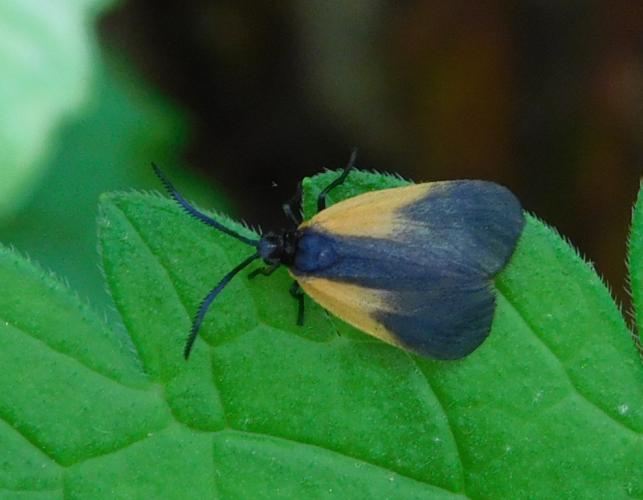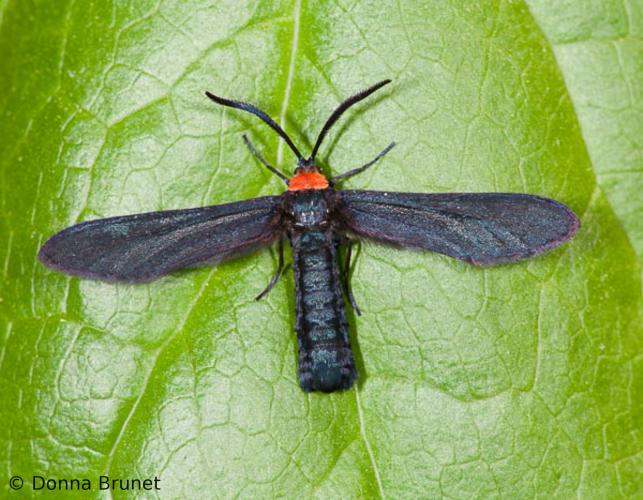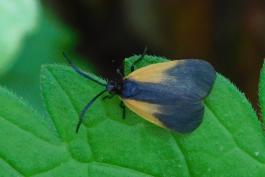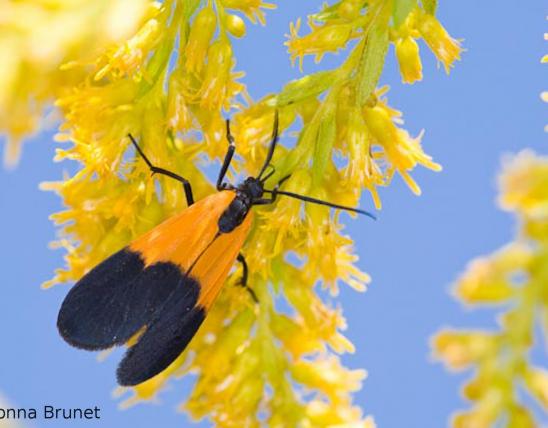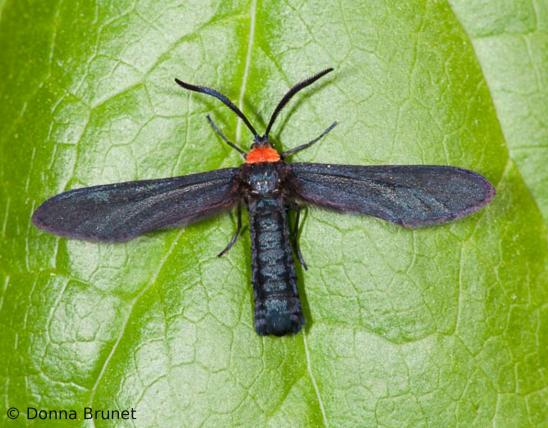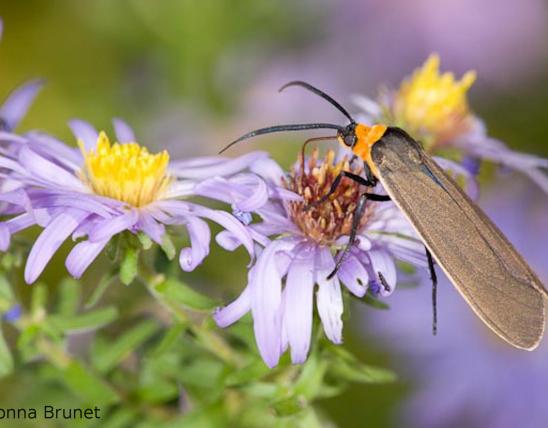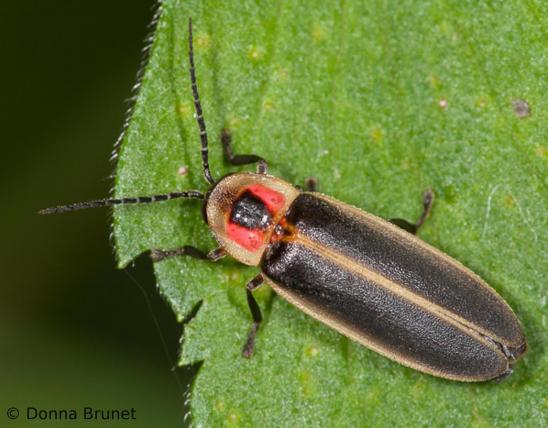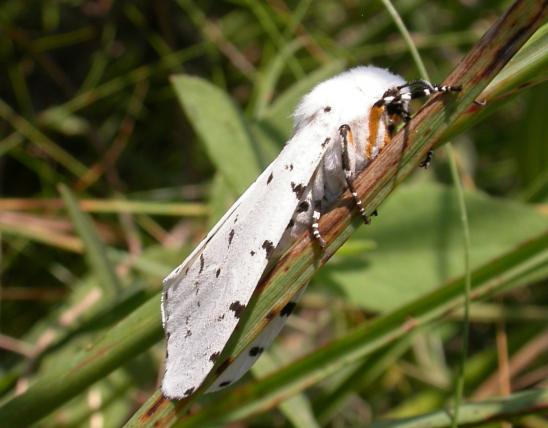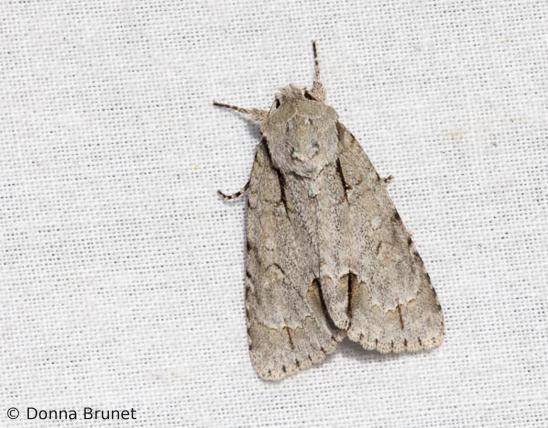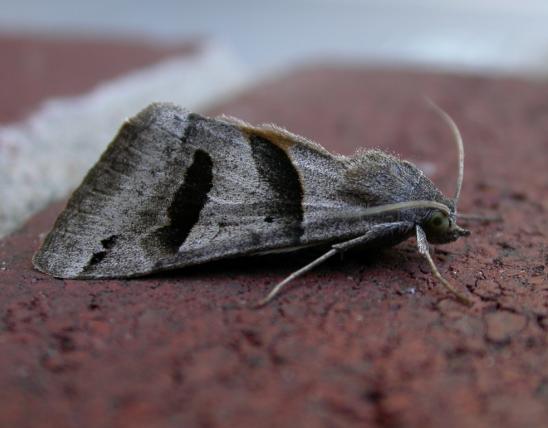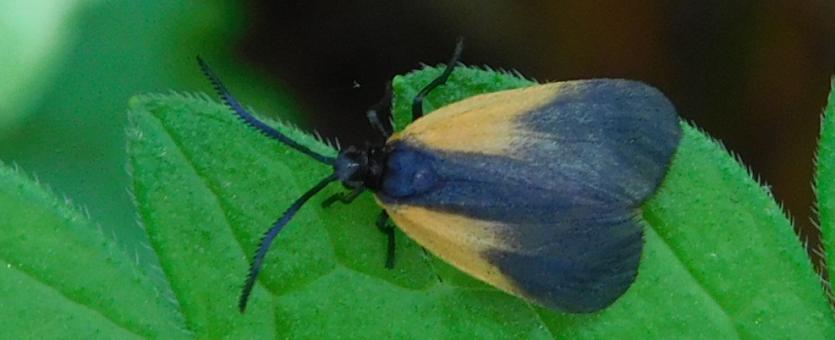
Leaf skeletonizer moths are also called smoky moths because they typically have translucent (not opaque), smoky-brown, brownish gray, or black wings, sometimes with a bluish sheen. Some species are marked with pale orange, bright orange, or rusty orange patches. The antennae are subtly widened in the middle, and those of males are comb-toothed. The forewings are rounded. Look for characteristic bristly patches above the eyes.
Some skeletonizer moths typically hold their wings out at a right angle to the body, in a T shape. Others fold their wings down the back, much as tiger and lichen moths do.
Larvae vary in coloration by species type. They have bristly hairs that can cause skin irritation if touched.
Similar species:
- The yellow-collared scape moth (Cisseps fulvicollis), a type of tiger moth, resembles some types of leaf skeletonizers, but unlike them it has angular, less rounded wings. Comparing photographs usually is enough to tell them apart.
- The Virginia ctenucha (Ctenucha virginica), is another type of tiger moth. With its wings spread out in a T shape, it strongly resembles grapeleaf skeletonizers (Harrisina spp.), but is larger and has a metallic blue body (including both abdomen and thorax) that contrasts with the brownish black of the wings. Its orange collar widens to extend more along the sides (“shoulders”) of the moth.
- Several types of lichen moths (a tribe alongside the tiger moths in family Erebidae) have black and orangish coloration and also fold their wings down the back. But lichen moths' wings are not translucent. One example is the black-and-yellow lichen moth, Lycomorpha pholus. Note also that the black-and-yellow lichen moth flies in late summer into fall, while its leaf-skeletonizer lookalike, the orange-patched smoky moth, flies in early summer only.
Wingspan: ½–1¼ inches (varies with species).
Statewide.
Habitat and Conservation
Unlike the majority of moths, leaf skeletonizer moths typically are active during the day. Many people see them as they visit flowers in gardens and other open places.
As with other plant-eating insects, leaf skeletonizer moths are especially abundant where their food plants occur. Moths whose host plants have a limited distribution tend to have a limited distribution themselves, so distribution can vary by species.
Because most leaf skeletonizers eat grape leaves as caterpillars, females must lay their eggs on grape plants. Mating activities typically occur near egg-laying sites, and these moths also predominate near the places where they had lived as caterpillars. In Missouri, most wild members of the grape family are especially common in bottomlands, streamsides, wooded valleys, and other damp, woody areas.
Moths, however, can fly any number of places, and wild and cultivated grapes may grow just about anywhere, so you might find leaf skeletonizers just about anywhere, too.
Food
Leaf skeletonizer moths are named because their larvae feed on the outsides of leaves. They chomp the tender parts and ignore the veins, leaving behind a lacy skeleton of the leaf. Most species feed on members of the grape family, including Virginia creeper, raccoon grapes, and peppervine, as well as the various grapes in genus Vitis. Some may be limited to eating only a handful of species, while others may be able to eat leaves from a wider variety of host plants. The orange-patched smoky moth (Pyromorpha dimidiata) reportedly eats fallen oak leaves on the forest floor, feeding on them from below.
Adults visit flowers for nourishment to sustain them during their courtship and reproductive activities.
Life Cycle
Number of broods varies with species. Like other moths and butterflies, leaf skeletonizers begin life as eggs, hatch into caterpillars, then undergo a number of larval molts, shedding their skin as they grow larger. Finally, they spin a cocoon and pupate within it, to emerge as winged, sexually mature adults. Many species live for only days in the adult form.
Human Connections
Owners of vineyards are not fond of any insects that eat grape leaves, but in our state, leaf skeletonizer moth caterpillars are not among the major insect pests of cultivated grapes, perhaps because there are so many wild grapes, Virginia creeper, raccoon grapes, and so on for them to feed on.
The western grapeleaf skeletonizer (Harrisina metallica) is a major pest of commercial grape vineyards in the western states. A black moth with bluish or greenish sheen, it occurs only in the southwestern part of our country, ranging from southern California to Wyoming, central Texas, and the Oklahoma panhandle, and in northern Mexico.
Ecosystem Connections
As with other insects with bold bright black and orange (or black and red) color patterns, leaf skeletonizers gain some protection from possible predators with their warning colors. Apparently, many species, as caterpillars, are able to store toxic plant chemicals in their bodies. In the case of leaf skeletonizers, the toxins are usually forms of cyanide, which would sicken a predator that has not yet learned that black and orange means "yuk."
